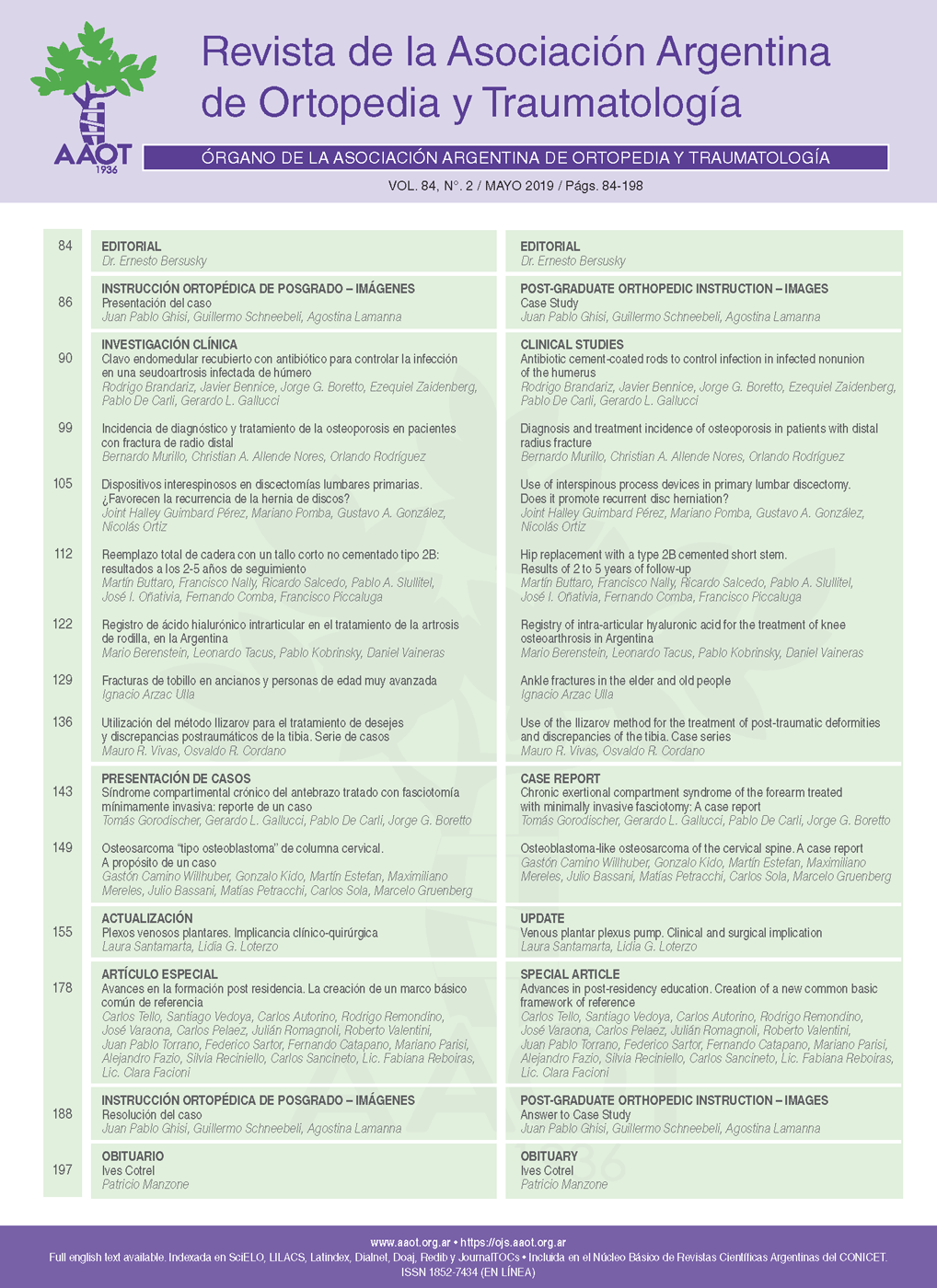Utilización del método Ilizarov para el tratamiento de desejes y discrepancias postraumáticas de la tibia. Serie de casos.[Use of the Ilizarov method for the treatment of post-traumatic deformity and discrepancies of the tibia]
Contenido principal del artículo
Resumen
Descargas
Métricas
Detalles del artículo

Esta obra está bajo licencia internacional Creative Commons Reconocimiento-NoComercial-CompartirIgual 4.0.
La aceptación del manuscrito por parte de la revista implica la no presentación simultánea a otras revistas u órganos editoriales. La RAAOT se encuentra bajo la licencia Creative Commons 4.0. Atribución-NoComercial-CompartirIgual (http://creativecommons.org/licenses/by-nc-sa/4.0/deed.es). Se puede compartir, copiar, distribuir, alterar, transformar, generar una obra derivada, ejecutar y comunicar públicamente la obra, siempre que: a) se cite la autoría y la fuente original de su publicación (revista, editorial y URL de la obra); b) no se usen para fines comerciales; c) se mantengan los mismos términos de la licencia.
En caso de que el manuscrito sea aprobado para su próxima publicación, los autores conservan los derechos de autor y cederán a la revista los derechos de la publicación, edición, reproducción, distribución, exhibición y comunicación a nivel nacional e internacional en las diferentes bases de datos, repositorios y portales.
Se deja constancia que el referido artículo es inédito y que no está en espera de impresión en alguna otra publicación nacional o extranjera.
Por la presente, acepta/n las modificaciones que sean necesarias, sugeridas en la revisión por los pares (referato), para adaptar el trabajo al estilo y modalidad de publicación de la Revista.
Citas
2. Ilizarov GI. Angular deformities with shortening. En: Coombs R, Green S, Sarmiento A (eds). External fixation and functional bracing. London: Orthotex; 1989:359-74. ISBN-13:978-0834200852
3. Jain AK, Sinha S. Infected nonunion of the long bones. Clin Orthop Relat Res 2005;(431):57-65. https://doi.org/10.1097/01.blo.0000152868.29134.92
4. Paley D. Principles of deformity correction, Berlin: Springer; 2002. https://doi.org/10.1007/978-3-642-59373-4
5. Ilizarov GI. Fractures and non-union. En: Coombs R, Green S, Sarmiento A (eds). External fixation and functional bracing. London: Orthotex; 1989:347-58. ISBN-13: 978-0834200852
6. Malik MH, Harwood P, Diggle P, Khan SA. Factors affecting rates of infection and nonunion in intramedullary nailing. J Bone Joint Surg Br 2004;86(4):556-60. https://doi.org/10.1302/0301-620X.86B4.14097
7. Paley D, Catagni M, Argnani F, Villa A, Benedetti GB, Cattaneo R. Ilizarov treatment of tibial nonunions with bone loss. Clin Orthop Relat Res 1989;(241):146-65. https://doi.org/10.1097/00003086-198904000-00017
8. Dahl MT, Gulli B, Berg T. Complications of limb lengthening. A learning curve. Clin Orthop Relat Res 1994;(301):10-8.
9. Krappinger D, Irenberger A, Zegg M, Huber B. Treatment of large posttraumatic tibial bone defects using the Ilizarov method: a subjective outcome assessment. Arch Orthop Trauma Surg 2013;133(6):789-95. https://doi.org/10.1007/s00402-013-1712-y
10. Bernstein M, Fragomen AT, Sabharwal S, Barclay J, Rozbruch SR. Does integrated fixation provide benefit in the reconstruction of posttraumatic tibial bone defects. Clin Orthop Relat Res 473(10)3143-53. https://doi.org/10.1007/s11999-015-4326-6
11. Chaddha M, Gulati D, Singh AP, Singh AP, Maini L. Management of massive posttraumatic bone defects in the lower limb with the Ilizarov technique. Acta Orthop Belg 2010;76(6):811-20. http://www.actaorthopaedica.be/acta/download/2010-6/17-Chadha%20et%20al.pdf
12. Cirpar M, Cetik O, Uslu M, Eksioglu F. Common complications of segmental bone transport with Ilizarov technique in defective tibia pseudoarthrosis: a review. Eur J Orthop Surg Traumatol 2006;16(4):380-5. https://doi.org/10.1007/s00590-006-0089-9
13. Krappinger D. Correction of posttraumatic lower leg deformities using the Taylor Spatial Frame. Oper Orthop Traumatol 2014;26(5):520-31. https://doi.org/10.1007/s00064-013-0233-8
14. Cattaneo R, Catagni M, Jonhson EE. The treatment of infected nonunions and segmental defects of the tibia by methods of Ilizarov. Clin Orthop 1985;280:143-52. https://doi.org/10.1097/00003086-199207000-00017
15. Stogov MV1, Luneva SN, Novikov KI. Growth factors in human serum during operative tibial lengthening with the Ilizarov method. J Orthop Res 2013;31(12):1966-70. https://doi.org/10.1002/jor.22454

